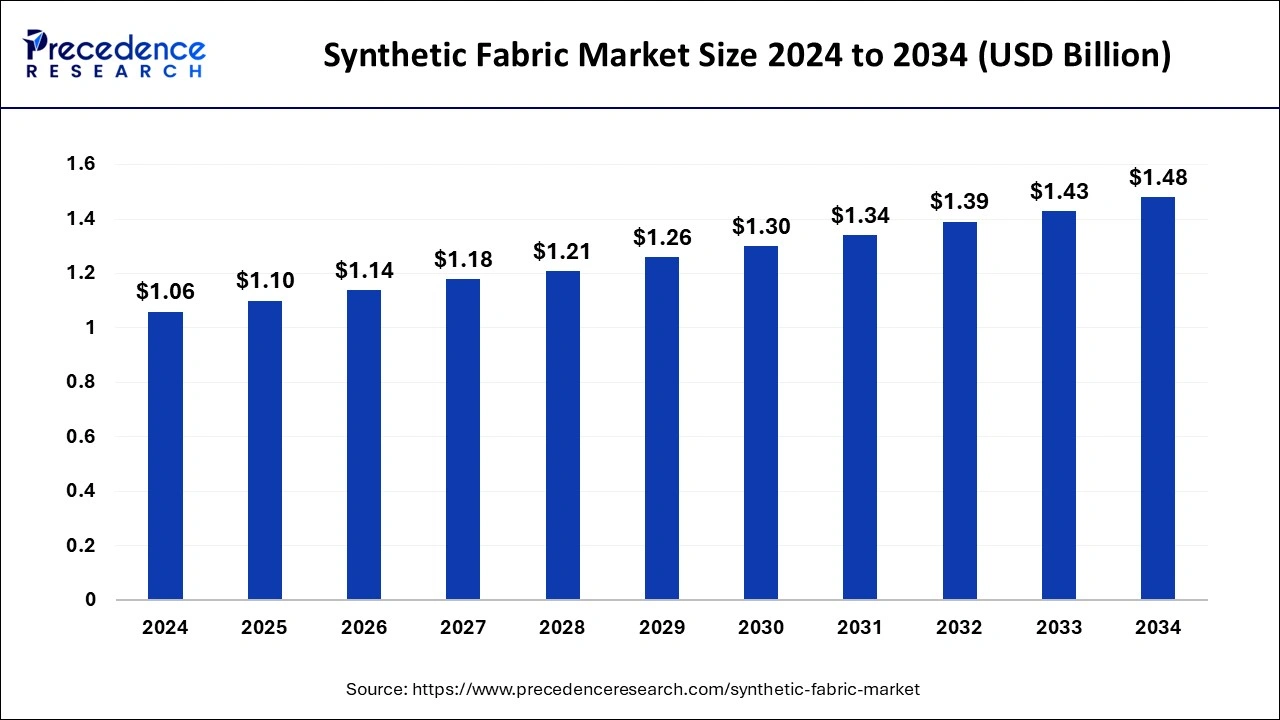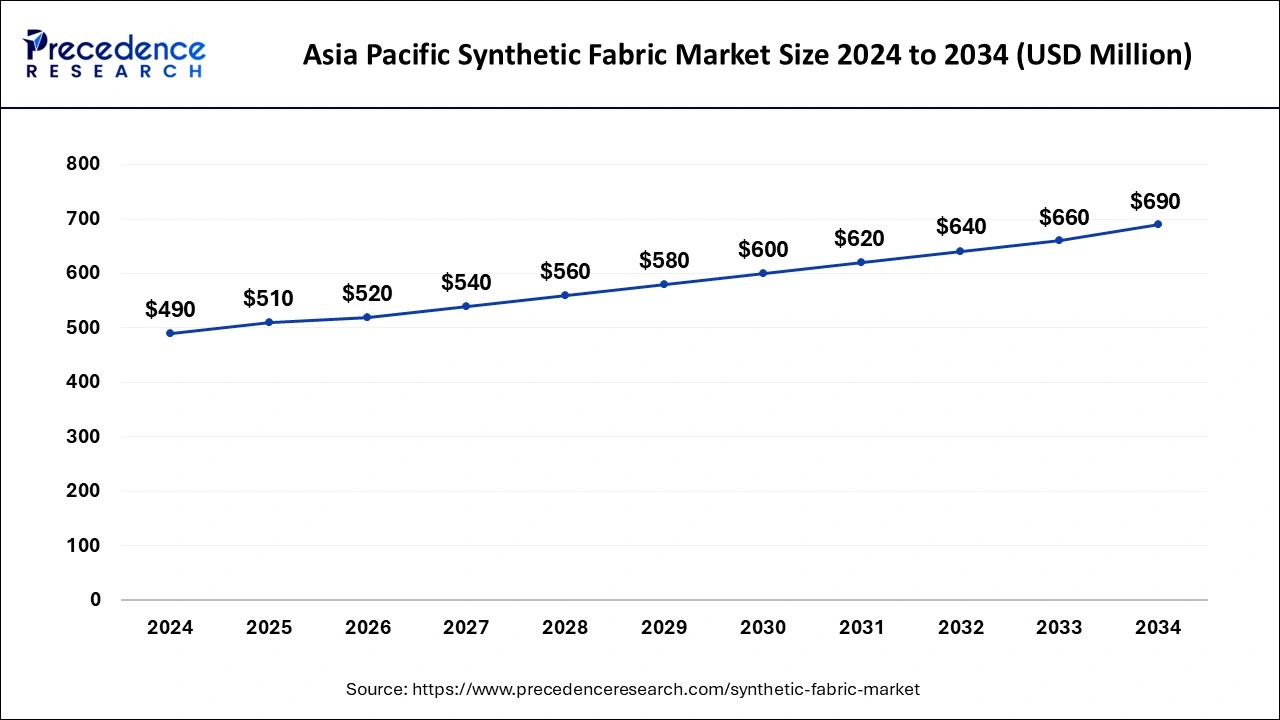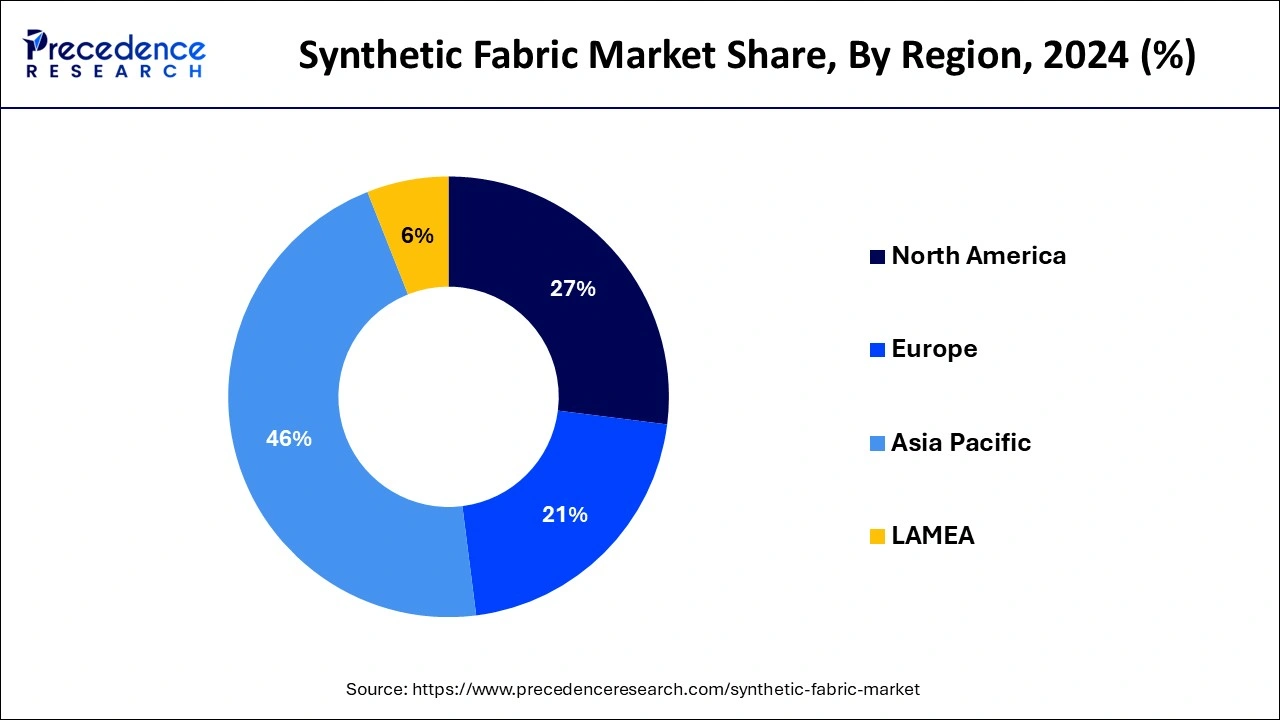Synthetic Fabric Market Size and Growth 2025 to 2034
The global synthetic fabric market size was estimated at USD 1.06 billion in 2024 and is predicted to increase from USD 1.10 billion in 2025 to approximately USD 1.48 billion by 2034, expanding at a CAGR of 3.39% from 2025 to 2034. The increased physical and chemical properties of synthetic fibers and cost-effective products are driving the market's growth.

Synthetic Fabric Market Key Takeaways
- The global synthetic fabric market was valued at USD 1.06 billion in 2024.
- It is projected to reach USD 1.48 billion by 2034.
- The market is expected to grow at a CAGR of 3.39% from 2025 to 2034.
- Asia Pacific dominated the synthetic fabric market with the largest market share in 2024.
- North America is expected to witness a significant growth rate in the market during the forecast period.
- By type, the acrylic fabric segment held a significant share of the market in 2024.
- By application, the apparel application segment held the largest share of the market in 2024.
Asia PacificSynthetic Fabric Market Size and Growth 2025 to 2034
The Asia Pacific synthetic fabric market size was estimated at USD 490 million in 2024 and is predicted to be worth around USD 690 million by 2034, at a CAGR of 3.48% from 2025 to 2034.

Asia Pacific dominated the synthetic fabric market with the largest market share in 2024. The growth of the market in the region is increasing due to the rising population, creating a higher demand for several industrial applications such as clothing, home furnishing, automobiles, and others, creating a higher demand for synthetic fabric. The rising revolutionary changes in the fashion and clothing industry and the ongoing investments in the development of the fashion industry in regional countries are expected to continue the growth of the market. The rising research and development activities related to the launch of products associated with synthetic fibers are further propelling the growth of the market.
- For instance, PM MITRA Parks launched in 2023 in different states of India. Under the PLI scheme, Rs. 2119 crores are invested in the project, and around 126 research projects are approved under the NTT Mission for specialty fiber and technical textiles. For the period of 2027-28, the government of India has invested Rs. 4445 crores for developing world-class infrastructure, which also includes plug-and-play facilities. The parks will act as a single place for spinning, weaving, dyeing/processing, and printing clothes.

North America is expected to witness a significant growth rate in the market during the forecast period. The growth of the market is expected to boost due to the rising demand for synthetic fibers in the automotive and clothing industry in the region. The higher availability of the major automobile players and the ongoing research on technological advancements with higher fuel efficiency in the automobile sector is accelerating the demand for synthetic fibers. Additionally, the rising fashion and clothing industry in the region is driving the expansion of the synthetic fabrics market.
Market Overview
Synthetic fabrics are manufactured by chemical processes from synthetic yarn, also known as synthetic fiber. Synthetic fabrics are completely man-made products that are made as an alternative to natural fibers like cotton and silk. It consists of the fibers like nylon, polyester, polyvinyl chloride (PVS), rayon, spandex, neoprene, acrylic, polyurethane, and polypropylene. These fabrics are easy to maintain and durable, have higher strength, wrinkle resistance, quick drying, versatility, and elasticity, and are low in cost compared to natural fabrics.
The increasing demand for alternatives to natural fiber products due to their higher cost, fast fashion, and the increasing popularity of synthetic fibers in different industrial applications due to their higher chemical and physical properties are driving the growth of the synthetic fabric market.
Synthetic Fabric Market Growth Factors
- The increasing demand for synthetic fabrics from the clothing and fashion industry is driving the expansion of the market.
- Rising consumer demand for durable, cost-effective, and low-maintenance fabrics in several industrial applications, such as clothing, home furnishing, automotive, and filtration, is driving the growth of the synthetic fabric market.
- Increasing living standards are driving the demand for luxurious lifestyles in terms of clothing, home interiors, and others, which are driving the demand for fabrics that possess higher chemical and physical properties like high elasticity, strength, softness, and others, which contributed to the growth of synthetic fabrics.
- The increasing trend in the clothing and fashion industry is one of the major driving factors for synthetic fibers. Many of the clothing segments are produced or designed using synthetic fabric materials, fueling the demand for higher production of synthetic fabrics.
- Rising investment in technological advancements in the production and use of synthetic fabrics in different industries is driving the expansion of the synthetic fabric market.
- Synthetic fabrics are lightweight and are needed in EVs for better battery performance. Therefore, the increased production of EVs helps in growing the market.
Market Scope
| Report Coverage | Details |
| Market Size in 2025 | USD 1.10 Billion |
| Market Size by 2034 | USD 1.48 Billion |
| Growth Rate from 2025 to 2034 | CAGR of 3.39% |
| Largest Market | Asia Pacific |
| Base Year | 2024 |
| Forecast Period | 2025 to 2034 |
| Segments Covered | By Type and By Application |
| Regions Covered | North America, Europe, Asia-Pacific, Latin America, and Middle East & Africa |
Market Dynamics
Driver
Rising demand from several industrial applications
Due to their higher strength and durability, the increasing demand for synthetic fabrics in different industrial applications such as textile, sports equipment, packaging, home textiles, medical, and automotive applications is driving the growth of the synthetic fabrics market. The textile industry is one of the major consumers of synthetic fabrics due to their higher elasticity, strength, and other physical properties. Synthetic fabrics like nylon, spandex, and polyester are the most commonly used in clothing, linens, and upholstery due to their cost-effectiveness and ease of maintenance.
Synthetic fabrics like polyester are highly used in the manufacturing of sportswear and outdoor activities due to their elasticity and quick-drying properties. Synthetic fabrics are also used in the manufacturing of sports equipment like fishing lines, tennis rackets, and ski ropes due to their higher resistance and strength with excellent stretching capacity. It is also used in the medical industry in the production of medical textiles, like sutures, medical implants, and wound dressing. Synthetic fabrics are biodegradable substances and do not react with human skin or tissue, which makes them an ideal fabric to use in the manufacturing of medical textiles.
Restraint
Insufficiency in raw material
The synthetic fabric market is facing significant challenges due to a combination of factors. Firstly, there is a fluctuation in the cost and availability of raw materials, which limits the expansion of synthetic fabrics in different applications. Secondly, the increasing cost of fiber processing is also a major issue, further restraining market growth. These limitations have resulted in a slowdown of the market's growth, with manufacturers struggling to keep up with demand and maintain profitability. Addressing these challenges will require cooperation between manufacturers and suppliers to ensure a stable supply of materials and find ways to reduce processing costs.
Opportunity
Expanding applications in the automotive industry
The rising demand for synthetic fabrics in the automotive industry to meet the rising demand for lightweight automobiles results in higher usage without compromising durability. Synthetic and conventional fibers are used in the manufacturing of automotive components like knitted, woven, nonwoven, and other composite structures. Synthetic fibers are also used in the different mechanical properties of the automobile, like sound insulation and abrasion resistance. Nylon is the most commonly used synthetic fabric in automobiles.
Polyester is used for proper upholstery and seat cushions. Carbon-woven fabrics are used in different car parts to make vehicles lightweight, especially electric vehicles. The rising demand for the automotive industry and the ongoing research and development on the innovations and launch of eco-friendly and fuel-efficiency vehicles are further driving the opportunity for the synthetic fabric market.
- In May 2024, Meisheng Group launched a new line of ANDRITZ needlepunch in Shaoxing. The company is known for producing high-end, nonwoven synthetic leather. The new facility was launched to meet the increasing demand for synthetic suede in the automotive industry.
Type Insights
The acrylic fabric segment dominated the synthetic fabric market in 2024. Acrylic fabric is often more affordable compared to other synthetic fibers like nylon or polyester. This makes it an attractive option for manufacturers looking to produce cost-effective textiles without compromising too much on quality. Acrylic fibers can mimic the feel and appearance of natural wool, making them popular for use in clothing, blankets, and upholstery where a wool-like texture is desired. Acrylic is often used as a wool substitute due to its warmth, softness, and lightweight nature. Acrylic can be easily blended with other fibers such as wool, cotton, or polyester to enhance certain properties of the resulting fabric. This versatility allows manufacturers to tailor acrylic blends to meet specific performance requirements for different applications.
Application Insights
The apparel segment had the largest share of the synthetic fabric market in 2024. Synthetic fabric covers 60% of the overall clothing brands, including fabrics like nylon and polyester, all of which are made from petroleum-derived polymers. One of the biggest driving factors is fast fashion, which increases the demand for more clothes and ultimately increases the production of synthetic fabrics. Increased disposable income, especially in developed countries, is also driving the growth of the segment.
The rising demand for synthetic fabrics in the clothing and fashion industry is due to their recyclability, which creates a sustainable alternative to natural fabric, and recycling old garments with new yarn that helps minimize landfill waste and conversation resources. The increasing demand for sustainable, cost-effective, durable, and flexible yarn to meet the demands of the fashion industry and the manufacturing of different patterns of clothing are driving the demand for synthetic fabric in the clothing industry.
Synthetic Fabric Market Companies
- Bombay Dyeing
- E. I. du Pont de Nemours and Company
- Indorama Corporation
- Lenzing AG
- Mitsubishi Chemical Holdings Corporation
- Reliance Industries Limited
- China Petroleum Corporation (Sinopec Corp.)
- Teijin Limited
- Toray Chemical Korea, Inc.
- Toyobo Co., Ltd.
Recent Developments
- In April 2024, Kawhi Leonard‘s fourth signature footwear released its New Balance Signature Footwear. The new style of sneaker incorporates an Energy Arc carbon fiber plate with FuelCell foam midsole cushioning sitting and strategic gaps beneath an engineered mesh top with synthetic overlays.
- In April 2024, Sika launched a state-of-the-art facility in Lima, Peru, for the manufacturing of synthetic fibers and increasing the product range with the enormous response in Latin America.
- In April 2024, JOGANI Reinforcement introduced JOGANI Super Mesh—a high–quality fiberglass mesh with a hole size of 10 mm by 10 mm for better mortar penetration, workability, and ease of fixing. It was launched for the first time in India and aims to increase durability and control cranks in construction.
- In May 2024, Hyosung, a leading player and the globally renowned manufacturer of spandex and the major supplier of other performance synthetic fibers, integrates the new facilities to increase the supply chain flexibility of the bio-based spandex.
Segments Covered in the Report
By Type
- Acetate Fabric
- Acrylic Fabric
- Chiffon Fabric
- Denim Fabric
By Application
- Construction
- Automotive
- Healthcare
- Apparel
- Household
- Others
By Geography
- North America
- Asia Pacific
- Europe
- Latin America
- Middle East & Africa
For inquiries regarding discounts, bulk purchases, or customization requests, please contact us at sales@precedenceresearch.com
Frequently Asked Questions
Ask For Sample
No cookie-cutter, only authentic analysis – take the 1st step to become a Precedence Research client
 sales@precedenceresearch.com
sales@precedenceresearch.com
 +1 804-441-9344
+1 804-441-9344